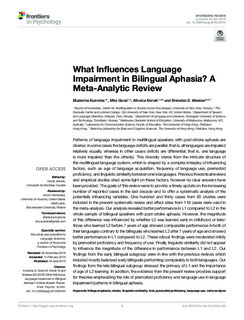| dc.contributor.author | Kuzmina, Ekaterina | |
| dc.contributor.author | Goral, Mira | |
| dc.contributor.author | Norvik, Monica I. | |
| dc.contributor.author | Weekes, Brendan | |
| dc.date.accessioned | 2019-07-09T08:31:57Z | |
| dc.date.available | 2019-07-09T08:31:57Z | |
| dc.date.created | 2019-04-11T09:15:41Z | |
| dc.date.issued | 2019 | |
| dc.identifier.citation | Frontiers in Psychology. 2019, 10:445 1-22. | nb_NO |
| dc.identifier.issn | 1664-1078 | |
| dc.identifier.uri | http://hdl.handle.net/11250/2603846 | |
| dc.description.abstract | Patterns of language impairment in multilingual speakers with post-stroke aphasia are diverse: in some cases the language deficits are parallel, that is, all languages are impaired relatively equally, whereas in other cases deficits are differential, that is, one language is more impaired than the other(s). This diversity stems from the intricate structure of the multilingual language system, which is shaped by a complex interplay of influencing factors, such as age of language acquisition, frequency of language use, premorbid proficiency, and linguistic similarity between one's languages. Previous theoretical reviews and empirical studies shed some light on these factors, however no clear answers have been provided. The goals of this review were to provide a timely update on the increasing number of reported cases in the last decade and to offer a systematic analysis of the potentially influencing variables. One hundred and thirty cases from 65 studies were included in the present systematic review and effect sizes from 119 cases were used in the meta-analysis. Our analysis revealed better performance in L1 compared to L2 in the whole sample of bilingual speakers with post-stroke aphasia. However, the magnitude of this difference was influenced by whether L2 was learned early in childhood or later: those who learned L2 before 7 years of age showed comparable performance in both of their languages contrary to the bilinguals who learned L2 after 7 years of age and showed better performance in L1 compared to L2. These robust findings were moderated mildly by premorbid proficiency and frequency of use. Finally, linguistic similarity did not appear to influence the magnitude of the difference in performance between L1 and L2. Our findings from the early bilingual subgroup were in line with the previous reviews which included mostly balanced early bilinguals performing comparably in both languages. Our findings from the late bilingual subgroup stressed the primacy of L1 and the importance of age of L2 learning. In addition, the evidence from the present review provides support for theories emphasizing the role of premorbid proficiency and language use in language impairment patterns in bilingual aphasia. | nb_NO |
| dc.language.iso | eng | nb_NO |
| dc.publisher | Frontiers Media | nb_NO |
| dc.rights | Navngivelse 4.0 Internasjonal | * |
| dc.rights.uri | http://creativecommons.org/licenses/by/4.0/deed.no | * |
| dc.title | What influences language impairment in bilingual aphasia? A meta-analytic review | nb_NO |
| dc.type | Journal article | nb_NO |
| dc.type | Peer reviewed | nb_NO |
| dc.description.version | publishedVersion | nb_NO |
| dc.source.pagenumber | 1-22 | nb_NO |
| dc.source.volume | 10:445 | nb_NO |
| dc.source.journal | Frontiers in Psychology | nb_NO |
| dc.identifier.doi | 10.3389/fpsyg.2019.00445 | |
| dc.identifier.cristin | 1691505 | |
| dc.relation.project | Norges forskningsråd: 223265 | nb_NO |
| dc.description.localcode | Copyright © 2019 Kuzmina, Goral, Norvik and Weekes. This is an open-access article distributed under the terms of the Creative Commons Attribution License (CC BY) | nb_NO |
| cristin.unitcode | 194,62,60,0 | |
| cristin.unitname | Institutt for språk og litteratur | |
| cristin.ispublished | true | |
| cristin.fulltext | postprint | |
| cristin.fulltext | original | |
| cristin.qualitycode | 2 | |

